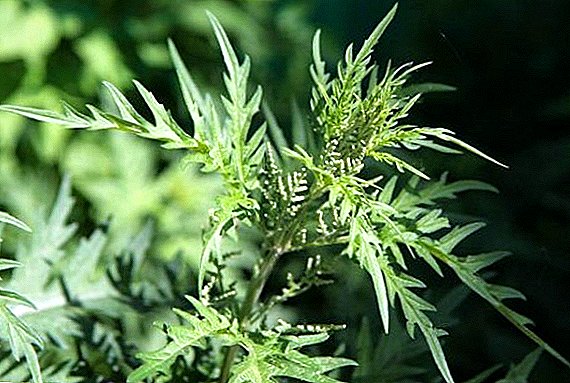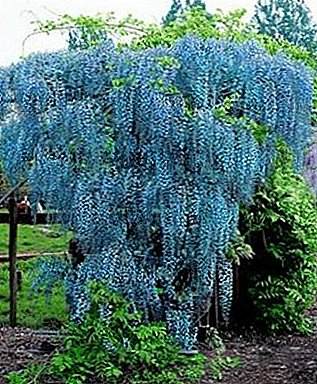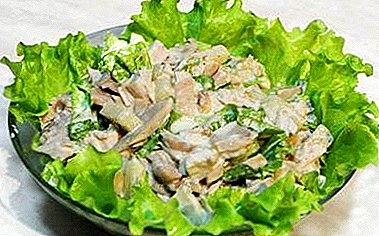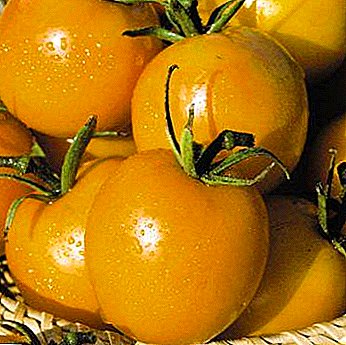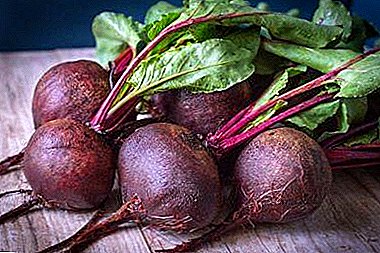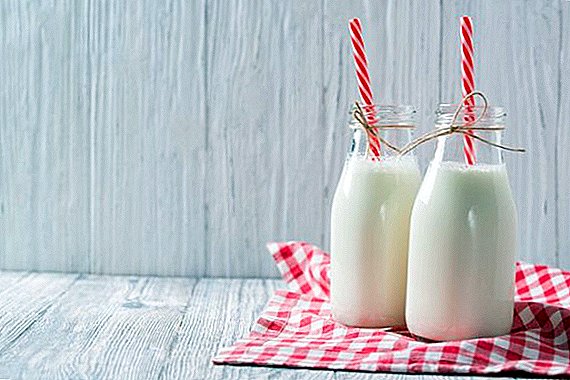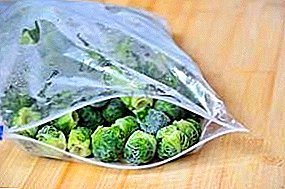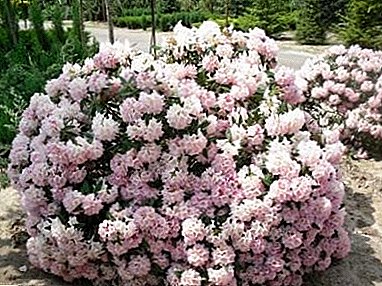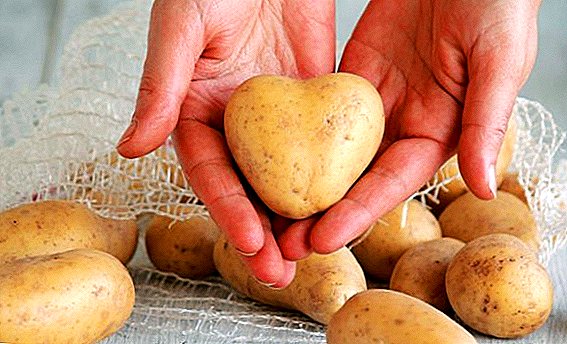 For many Ukrainian families, potatoes are the second bread.
For many Ukrainian families, potatoes are the second bread.
Without it, it is difficult to imagine an ordinary and festive table. Moreover, modern cooks can cook anything from these nutritious vegetables. But does the plant justify such people's love?
Later in the article we will talk about the beneficial and harmful properties of potato tubers, as well as focus on the characteristics of their varieties.
Calorie and chemical composition
The components of potato are largely dependent on climatic, weather and soil conditions of cultivation.  Also determining factors are the genetic characteristics of varieties and their degree of maturity.
Also determining factors are the genetic characteristics of varieties and their degree of maturity.
Important! Early varieties of potatoes after ripening the fruit must be excavated. If you overdo them in the ground, re-germination will begin.
According to scientists, in every tuber to some extent contain:
- Water - takes up to 76%.
- Starch - on average takes up to 80% of the total composition. Under cellar conditions, its amount is rapidly decreasing, which is associated with the conversion of starchy grains into sugars.
- Saharas - represented by maltose, sucrose, glucose and phosphate esters. But the more of these components are contained in the fruit, the worse their quality. Too sugary specimens are sweet in taste and darken when cooked.
- Cellulose - contains only 1%. It is more concentrated near the peel, less than its core.
- Hemicellulose - the content is 1 percent, together with the fiber is the basis of cells.

- Nitrogenous substances - represented by raw protein, make up about 3%. Their peculiarity lies in the fact that according to their biological value they are practically not inferior to meat, egg and cereal proteins. This fact is explained by the interacting essential amino acids.
- Vitamins PP, K, E C, B1, B2, B6, pantothenic acid, orphan, inositol, biotin.
- Minerals - sodium, boron, magnesium, iron, iodine, manganese, cobalt, magnesium, sulfur, zinc, silicon, bromine, copper, chlorine. But they are distributed unevenly in tuber. The greatest amount accumulates the skin, and the smallest - the core of the fetus.
- Mineral salts - These are mainly potash and phosphorus formations, which contribute to the alkaline balance of blood cells.
- Amino Acids - lysine, valine, isoleucine, tryptophan, methionine, leucine, phenylalanine, threonine.
- Organic acids - lemon, apple, isolimon, oxalic, wine, dairy, quinine, pyruvic, chlorogenic.

- Titrated acids - make up no more than 12%.
- Carotenoids - are coloring matter. In yellow fruit potatoes amount to 0.15%, and in white fruit - 0.02%.
- Flavones, anthocyanins, flavonoids - are the main components of potato peel.
- Coumarins.
- Amides - represented by glutamine and asparagine.
- Nitrogenous glycosides - chakonin and solanine. The impact of these components is noticeable by a certain bitterness appearing in the mouth when the peel is chewed. If you store potatoes under the light, the amount of glycoalkaloids in its composition increases, as a result of which the fruit becomes poisonous.
- Pectins - equal to 0.7%.
 On average, per 100 grams of raw potato fruits, experts calculated 4.6 g of proteins, 0.4 g of fats, and 18.1 g of carbohydrates with a caloric content of 80 kcal. It is noted that fats consist of myristic, palmitic, linoleic, and linolenic acids, which are characterized by the most important nutritional value.
On average, per 100 grams of raw potato fruits, experts calculated 4.6 g of proteins, 0.4 g of fats, and 18.1 g of carbohydrates with a caloric content of 80 kcal. It is noted that fats consist of myristic, palmitic, linoleic, and linolenic acids, which are characterized by the most important nutritional value.Did you know? The first potato discovered Indian tribes. And Europeans, having learned about a tasty vegetable, were in no hurry to introduce it into their daily diet and showed more interest in flowers. For the French, it was a decoration in hairstyles, and for German women - garden decor.
What is good for the body?
No wonder the potato so confidently entered the lives of people. For thousands of years of its existence, there was no other so affordable and useful product. According to scientists, a kilogram of raw tubers may well provide a person with a daily rate of ascorbic acid and some other vitamins, minerals. In addition, the vegetable helps to normalize metabolic processes, excretion of excess fluid from the body.
We advise you to read about the beneficial properties of tomatoes, carrots, squash, pumpkin, melon, chili pepper, lettuce (iceberg), parsnip, asparagus beans, beans, celery, radish, garlic, horseradish.
The beneficial effect of potatoes on health, its high energy value has long been noticed by physicians. In medical practice is widely used fresh juice of tubers for the treatment of gastritis, ulcers of the digestive tract.  Due to its rich composition, the product has anti-inflammatory, tonic and enveloping effect. Of particular importance to fruits are the constituent proteins, which are the most complete in the plant group. The use of baked and boiled potatoes in their skins is indisputable: it helps normalize the function of the kidneys and the gastrointestinal tract, and also retains all the beneficial substances.
Due to its rich composition, the product has anti-inflammatory, tonic and enveloping effect. Of particular importance to fruits are the constituent proteins, which are the most complete in the plant group. The use of baked and boiled potatoes in their skins is indisputable: it helps normalize the function of the kidneys and the gastrointestinal tract, and also retains all the beneficial substances.
Did you know? In order for French landowners to overcome their fear of potatoes and began to cultivate them, the local farmer Antoine-Auguste Parmentier decided to outwit everyone. He resorted to a psychological stunt that aroused wild curiosity among others. Monsieur planted his fields with tubers and put stern guards on them for the day, and at night access to the garden was open. Many could not resist scouting what was so guarded by a respected gentleman in the region. As a result, over time, potatoes began to grow far beyond the protected area.
Folk healers advise to use mashed hot tubers as compresses for the treatment of cough, eczema and other skin lesions. Grated raw potatoes help with fungal and erysipelas diseases.
Potatoes in cooking from different countries
Probably, of all the vegetable diversity, there is no product that could be compared in its popularity with potatoes. It is boiled, baked, stewed, fried, baked. It is one of the essential ingredients of soups, salads, dumplings and stews. In addition, today there are many recipes for potato pancakes, zraz, dumplings and meatballs. And all these culinary masterpieces are considered "native" in every corner of the world.
Important! The lethal dose of the toxic substance of solanine is found in green berries, ripening from inflorescences, as well as in greened tubers. In order to get a serious poisoning, it is enough to eat 1 berry or a kilogram of tubers lying in the sun.
 European society began to eat potatoes at the beginning of the seventeenth century.
European society began to eat potatoes at the beginning of the seventeenth century.
The first recipes with this valuable product were collected in a book. "Ouverture de cuisine" french author Lancelot de casto.
The publication was published half a century after the product from the South American coast was brought by travelers to Spain. At first people were afraid of eating unknown tubers, but over time they recognized and fell in love.
French peoplewhich are considered the most sophisticated connoisseurs of taste, in these ancient recipes, boiled potatoes were consumed with butter, and also extinguished them in wine with nutmeg and baked in ashes.
Read also about the properties and application of different types of onions: chives, bulb, shallot, batun, slizuna.
While the potatoes reached the Russian table, Western Europe was already engaged in the cultivation of new varieties and advised exquisite culinary masterpieces from its fruits. Russians For a long time, the vegetable was considered a "devilish apple" and could not accept the thought of its benefits to human health.  A special love for the plant imbued with Belarusians. To this day, this culture is leading in the country's vegetable production and is considered the main dish of any table.
A special love for the plant imbued with Belarusians. To this day, this culture is leading in the country's vegetable production and is considered the main dish of any table.
Did you know? According to the International Finance Corporation, every year Ukrainians eat about 4 million tons of potatoes, and collect 19 million tons from fields and gardens.
Indian tribeswhich thousands of years ago discovered the wonderful fruits, made from them canned "chuno". For this purpose, the vegetables were first frozen and then dried naturally. Such a dish did not spoil even after 4 years.  Modern Peruvian people still keeps the recipe "Juancayna Pappas". The dish is an ordinary potato "in uniform", peeled and cut into slices, then poured with melted cheese sauce, milk, vegetable oil, lemon juice, cream and black pepper.
Modern Peruvian people still keeps the recipe "Juancayna Pappas". The dish is an ordinary potato "in uniform", peeled and cut into slices, then poured with melted cheese sauce, milk, vegetable oil, lemon juice, cream and black pepper.
We advise you to read about the benefits, harm and culinary use of herbs: dill, parsley, arugula, basil, cress, oregano, coriander, cardamom, mint, lemon balm.
But the world famous French fries It is prepared by wrapping foil of washed tubers followed by baking. Then they are peeled, spread in clay pots, poured sour cream, add nutmeg, butter, salt and bake again.  All foreign guests Scotland local chefs offer to try breaded potatoes, which is a national dish. It is made from boiled tubers that are boiled and cleaned and cut into slices. They are rolled in a pre-prepared mixture of finely chopped ham, salt, flour and bread crumbs. The finished slices are dipped in batter and fried in butter.
All foreign guests Scotland local chefs offer to try breaded potatoes, which is a national dish. It is made from boiled tubers that are boiled and cleaned and cut into slices. They are rolled in a pre-prepared mixture of finely chopped ham, salt, flour and bread crumbs. The finished slices are dipped in batter and fried in butter.
Important! In order for the harvest of potatoes to be well preserved, it should be placed in separate compartments in the cellar, away from apples. The fact is that fruits emit substances that contribute to the rapid ripening and aging of all nearby fruits.
What varieties are suitable for
To find the ideal potato variety for boiling, frying, stewing and baking, you need to be well versed in the level of starchy varieties. After all, the more in the fruits of this component, the more delicious they are. Such a potato has a powdery crumbly texture.
For example, the 'Russets' variety is just perfect for making pancakes, cooking mashed potatoes and fries. It absorbs well cream and milk, is able to retain a lot of oxygen, due to what it seems airy. Along with this high starch varieties easily absorb water and therefore fall apart during cooking. This means that for salads this type is not suitable. Here are varieties "Synthesis" and "Temp".  Tubers with average starch seem a bit wetter than the previous ones and keep their shape well. Their experienced chefs are advised to use for casseroles, roasting in foil or frying. We are talking about the yellow Finns, purple and white tubers. They are also suitable for filling and potato salad, because they are characterized by soft pulp, easy to boil soft. Among the popular varieties "Vector", "Adretta", "Zhuravinka".
Tubers with average starch seem a bit wetter than the previous ones and keep their shape well. Their experienced chefs are advised to use for casseroles, roasting in foil or frying. We are talking about the yellow Finns, purple and white tubers. They are also suitable for filling and potato salad, because they are characterized by soft pulp, easy to boil soft. Among the popular varieties "Vector", "Adretta", "Zhuravinka".
Important! In order to find out at home the level of starch in a potato tuber, cut it in half, then intensively rub the resulting lobules together. The water that appeared on the cut indicates a dense, indigestible pulp and low starchiness. Well, if the halves stick together, then you have in your hands a high-starch instance.
Tubers in which low in starch grainsThey are distinguished by a very dense "wax" structure, which is poorly digested. Such specimens are more suitable for salads. Often they are determined by the red, ruby peel and yellow core. These are the varieties 'Rose Finn Apple', 'Butterfinger', "Sifra", "Aladdin", "Rumba", "Annushka", "Carrera". 
Read also about the varieties of potatoes: "Kiwi", "Luck", "Gala", "Queen Anne", "Rosara", "Blue", "Irbitsky".
Recipes for use in traditional medicine
The benefits of raw potatoes does not go to any comparison with boiled or baked. Fresh sod tubers are recommended for cardiovascular diseases, as well as ulcers, puffiness of various origins, nausea.
Folk healers are advised to ingest no more than 150 g of slurry obtained 30 minutes before meals. Be prepared that at first it will be difficult to swallow such an amount of unpleasant medicine, so start with a 30-gram dose, gradually increasing it to a specified portion.
Grated potato paste is very effective for external use. With its help you can get rid of painful, long healing wounds, burns and even warts. But in this case, the gruel needs a little squeeze out of the wrap in cheesecloth.
When hemorrhoids are very effective candles from raw tubers. Treatment should be continued for 3 weeks, followed by a repeat in a month. 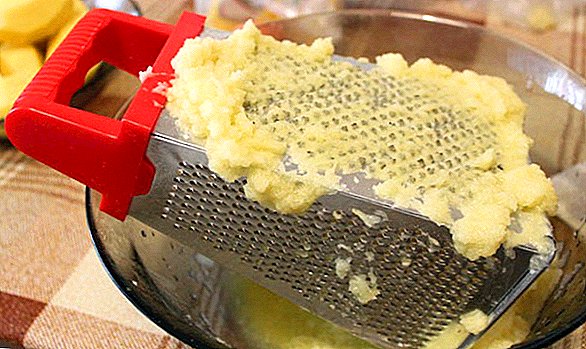 Do not rush to pour out the remaining water after boiling the potatoes. This decoction can save you from tormenting colic with urolithiasis. Especially valuable is the remaining liquid after the potato "in uniform". They drink it in a quarter cup for 20 days with a break of 1 month.
Do not rush to pour out the remaining water after boiling the potatoes. This decoction can save you from tormenting colic with urolithiasis. Especially valuable is the remaining liquid after the potato "in uniform". They drink it in a quarter cup for 20 days with a break of 1 month.
Did you know? The following fact has gone down in history: Spanish farmers have flatly refused to grow potatoes. The explanation for this was very simple: the potato resembled the shape of people and frightened superstitious people.
Coughing and inflammatory processes in the upper airways are very helpful. potato inhalations. To do this, boiled tubers sprinkled with a small amount of baking soda and inhale hot steam for 15 minutes.
Familiar for many delicacy in the form of baked potatoes on a coal helps to get rid of diarrhea, allergic reactions. For treatment, it is enough to clean the coal and rind, after which you can enjoy the cooked dish.  Some herbalists for cancer treatment are advised to brew a tablespoon of plant flowers with 1 liter of boiling water. After the liquid is infused on the steam bath or in a thermos for 3 hours, it must be drained. Take an infusion of tablespoon 30 minutes before meals. After using 4 liters of fluid, you need to take a four-week break. But in such cases, the therapy is very individual. Therefore, do not experiment with your body - be sure to consult with your doctor.
Some herbalists for cancer treatment are advised to brew a tablespoon of plant flowers with 1 liter of boiling water. After the liquid is infused on the steam bath or in a thermos for 3 hours, it must be drained. Take an infusion of tablespoon 30 minutes before meals. After using 4 liters of fluid, you need to take a four-week break. But in such cases, the therapy is very individual. Therefore, do not experiment with your body - be sure to consult with your doctor.
Did you know? The most expensive potato variety in the world is considered to be 'La Bonnotte', which is widely cultivated on the island of Noirmoutier. A kilogram will cost 500 euros.
Recipes home cosmetology
If you want to have supple and velvety skin, prepare a mask of new potatoes. Twenty minutes of application will be sufficient to obtain the desired result and smoothing small facial wrinkles. In addition, the potato whitens and nourishes the skin with vitamins. To enhance the effect, many ladies add warm milk to the household product.  For cosmetic purposes, raw, boiled tubers, as well as freshly squeezed juice are most often used. Such masks promote cell regeneration, moisturize, soften and tone up the skin. At the same time, the agent does not irritate the epidermis and does not cause allergies, but tightens enlarged pores.
For cosmetic purposes, raw, boiled tubers, as well as freshly squeezed juice are most often used. Such masks promote cell regeneration, moisturize, soften and tone up the skin. At the same time, the agent does not irritate the epidermis and does not cause allergies, but tightens enlarged pores.
It will be useful for girls to learn how to use rosemary, marjoram, coltsfoot, calendula, nettle, enoteru, periwinkle, savory for cosmetic purposes.
Aging and tired skin will help mask with milk. For its preparation you need to cook 1 tuber in milk and mash it in mashed potatoes. Then add the juice of 1 cucumber and apply for 15 minutes.
Toning mask is made from 1 boiled potato, a teaspoon of sour cream and the same amount of olive oil. The tool is recommended to apply a double layer on the massage lines.
Did you know? In Germany, the name of the potato is associated with the words "Kraft" and "trofel", which literally translates as "diabolical power."
For oily skin a remedy of 2 raw tubers, 1 beaten yolk, a tablespoon of milk and 1 teaspoon of lemon juice and a light beer will be useful. Also do not interfere with a little salt. All components are added to the grated potato gruel and mix thoroughly. Apply on the face, avoiding the area around the eyes, and incubated for 25 minutes, then washed off with warm water.  For Cuticle softening and hand skin rejuvenation recommended trays of vegetable decoction. It can also be applied to the hair, which contributes to the nutrition of hair follicles and the improvement of hair.
For Cuticle softening and hand skin rejuvenation recommended trays of vegetable decoction. It can also be applied to the hair, which contributes to the nutrition of hair follicles and the improvement of hair.
Learn more about the beneficial properties and use of different types of cabbage: white, red, kohlrabi, broccoli, Savoy, Peking, kale, pak choi, romanesco, as well as the popular dish of this vegetable - sauerkraut.
Contraindications and harm
The flesh and rind of potatoes, thanks to the solanine they contain, can bring not harm, but harm. It is characteristic that in tubers it is concentrated in small quantities. And with a long stay of the fruit under good lighting, their colors change to green. This suggests an increase in toxin in the composition of tubers. If you come across such specimens, the green part must be removed to light flesh.
Important! Toxic chemicals on potatoes can be used no more than two times per season. Otherwise, the tubers will absorb toxic substances and will be unsuitable for consumption.
Proper use of potatoes does not harm. But if you eat only these vegetables for a long time, you are guaranteed to get weight gain. To prevent this from happening, consume at least 200 g of baked or boiled product. But fried and cooked in a deep fryer dishes do not bring anything good.From such nutrition problems with the digestive tract, liver and pancreas. Consider that if 100 g of raw potatoes have only 80 kilocalories, then there are 500 of them in the same amount of fries.  Do not forget that in the composition of the fruit are water-soluble nutrients. Therefore, if you add a lot of water when cooking potato dishes, all the vitamins, proteins and healthy salts will go away.
Do not forget that in the composition of the fruit are water-soluble nutrients. Therefore, if you add a lot of water when cooking potato dishes, all the vitamins, proteins and healthy salts will go away.
We recommend that you familiarize yourself with the beneficial properties of mushrooms: mushrooms, honey agaric, ceps, milk mushrooms, butter.
Potatoes not recommended people with sexually transmitted diseases and increased sexual excitability. Contraindications also apply to people suffering from urolithiasis, enterocolitis, enteritis, bowel disease, flatulence, obesity. With caution to such therapy and culinary dishes should be treated by those who have an increased acidity of gastric juice and diabetes. In any case, it is important to consult a specialist and not to self-medicate.
Now you have learned how useful and harmful potatoes are, whether it can be eaten raw, how to prepare medicine and skin care products, for whom it is better to abstain from the usual product. We hope this knowledge will help you to choose the right variety for an unsurpassed time or another dish. Take care of yourself and remember that everything is good in moderation.


